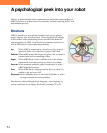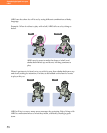
54
A psychological peek into your robot
The key to better human-robot communication and better understanding of
AIBO’s behavior is to be aware of its emotions, instincts, learning ability and
maturational process.
Emotions
AIBO is sensitive to and can feel emotions such as joy, sadness,
anger, surprise, fear and discontent. These emotions will change
in accordance with contributing factors and affect the behavior
and maturation of AIBO. Listed below are common scenarios in
which AIBO may be seen expressing emotions.
Joy: When AIBO is immersed in a favorite activity, receives
approval, finds a favorite color or plays with a ball.
Sadness: When AIBO cannot find anyone to play with, or when it
cannot find a ball or something it likes.
Anger: When AIBO finds a color it dislikes, left on the station
when ready to resume activity, or when it is scolded.
Surprise: When someone suddenly grabs its attention, or when
AIBO hears loud sounds.
Fear: When AIBO finds a large gap on the floor, or when it is
unable to get up from a fall.
Discontent: When someone shows a color that it dislikes, or when
its anger towards someone escalates.
Emotions are shown through body language , tone language as
well as variations in eye lights. For details, see pages 57 to 59.
Joy
Discontent
Sadness
Anger Surprise
Fear


















